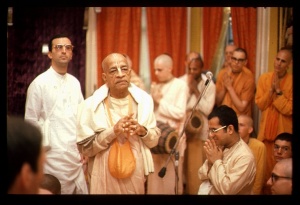CC Antya 5.14: Difference between revisions
m (1 revision(s)) |
No edit summary |
||
| Line 1: | Line 1: | ||
{{ | [[Category:Sri Caitanya-caritamrta - Antya-lila Chapter 05]] | ||
<div style="float:left">'''[[Sri Caitanya-caritamrta|Śrī Caitanya-caritāmṛta]] - [[CC Antya|Antya-līlā]] - [[CC Antya 5|Chapter 5: How Pradyumna Miśra Received Instructions from Rāmānanda Rāya]]'''</div> | |||
<div style="float:right">[[File:Go-previous.png|link=CC Antya 5.13|Antya-līlā 5.13]] '''[[CC Antya 5.13|Antya-līlā 5.13]] - [[CC Antya 5.15|Antya-līlā 5.15]]''' [[File:Go-next.png|link=CC Antya 5.15|Antya-līlā 5.15]]</div> | |||
{{CompareVersions|CC|Antya 5.14|CC 1975|CC 1996}} | |||
{{RandomImage}} | |||
==== TEXT 14 ==== | ==== TEXT 14 ==== | ||
<div | <div class="verse"> | ||
sei duṅhe lañā rāya nibhṛta udyāne | :sei duṅhe lañā rāya nibhṛta udyāne | ||
nija-nāṭaka-gītera śikhāya nartane | :nija-nāṭaka-gītera śikhāya nartane | ||
</div> | </div> | ||
| Line 12: | Line 16: | ||
==== SYNONYMS ==== | ==== SYNONYMS ==== | ||
<div | <div class="synonyms"> | ||
sei | ''sei duṅhe''—those two; ''lañā''—taking; ''rāya''—Rāmānanda Rāya; ''nibhṛta udyāne''—in a solitary place in the garden; ''nija-nāṭaka''—of the drama composed by him; ''gītera''—of the songs; ''śikhāya''—gives direction; ''nartane''—in dancing. | ||
</div> | </div> | ||
| Line 19: | Line 23: | ||
==== TRANSLATION ==== | ==== TRANSLATION ==== | ||
<div | <div class="translation"> | ||
"Śrīla Rāmānanda Rāya has taken these two girls to a solitary place in his garden, where he is teaching and directing them to dance according to the songs he has composed for his drama. | |||
</div> | </div> | ||
| Line 26: | Line 30: | ||
==== PURPORT ==== | ==== PURPORT ==== | ||
<div | <div class="purport"> | ||
The drama being rehearsed by Rāmānanda Rāya and the two young girls was the well-known Jagannātha-vallabha-nāṭaka. The songs and dances were meant for the pleasure of Lord Jagannātha; therefore Rāmānanda Rāya was personally giving instructions on how to sing and dance for the drama. | The drama being rehearsed by Rāmānanda Rāya and the two young girls was the well-known ''Jagannātha-vallabha-nāṭaka''. The songs and dances were meant for the pleasure of Lord Jagannātha; therefore Rāmānanda Rāya was personally giving instructions on how to sing and dance for the drama. | ||
</div> | </div> | ||
__NOTOC__ | |||
<div style="float:right; clear:both;">[[File:Go-previous.png|link=CC Antya 5.13|Antya-līlā 5.13]] '''[[CC Antya 5.13|Antya-līlā 5.13]] - [[CC Antya 5.15|Antya-līlā 5.15]]''' [[File:Go-next.png|link=CC Antya 5.15|Antya-līlā 5.15]]</div> | |||
__NOTOC__ | |||
__NOEDITSECTION__ | |||
Revision as of 16:19, 28 September 2021

A.C. Bhaktivedanta Swami Prabhupada
TEXT 14
- sei duṅhe lañā rāya nibhṛta udyāne
- nija-nāṭaka-gītera śikhāya nartane
SYNONYMS
sei duṅhe—those two; lañā—taking; rāya—Rāmānanda Rāya; nibhṛta udyāne—in a solitary place in the garden; nija-nāṭaka—of the drama composed by him; gītera—of the songs; śikhāya—gives direction; nartane—in dancing.
TRANSLATION
"Śrīla Rāmānanda Rāya has taken these two girls to a solitary place in his garden, where he is teaching and directing them to dance according to the songs he has composed for his drama.
PURPORT
The drama being rehearsed by Rāmānanda Rāya and the two young girls was the well-known Jagannātha-vallabha-nāṭaka. The songs and dances were meant for the pleasure of Lord Jagannātha; therefore Rāmānanda Rāya was personally giving instructions on how to sing and dance for the drama.